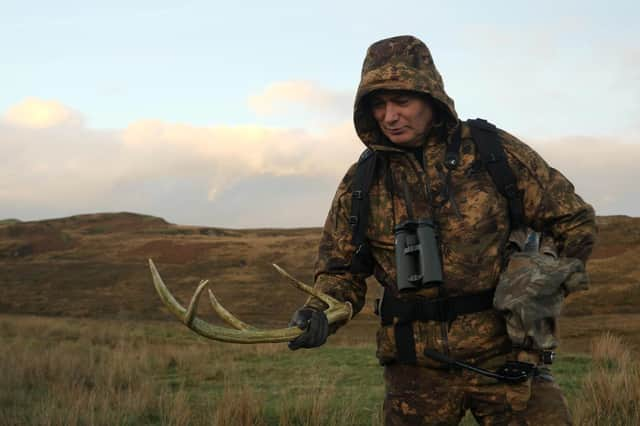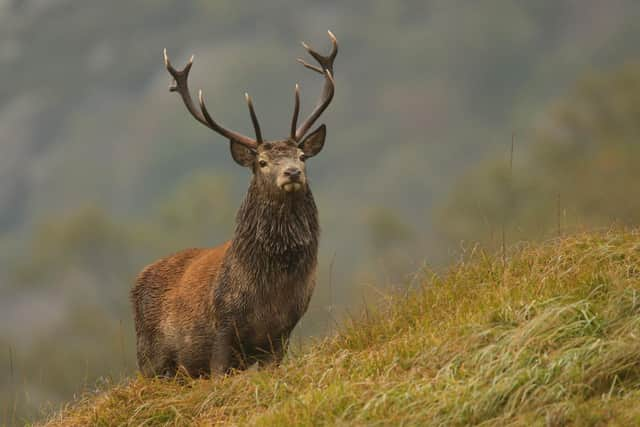The secret life of deer during the rutting season is captured by North Yorkshire wildlife artist Robert E Fuller


This stunning region is home to impressive herds of red deer. There are estimated to be 1,000 red deer living on the 50 square-mile peninsula, which amounts to roughly 20 deer per square mile.
I’ve been to this part of Scotland many times before, but never in autumn when the red deer rut takes place. This is when male stags compete for females in dramatic, often noisy, standoffs.
Advertisement
Hide AdAdvertisement
Hide AdAfter a nine-hour drive, I stopped at a viewpoint over-looking Ben Hiant, one of the region’s highest peaks.


As soon as I got out of my car, I could hear the roar of stags ringing out across the valley and instantly picked out a group of females, known as hinds, in the landscape. A stag was standing guard over them.
I last visited Ardnamurchan in late August. Then, stags and hinds were separate: the hinds together in herds and the males in bachelor groups, their half-grown antlers still coated in soft fur, known as velvet.
Now, just six weeks later, everything had changed.
The stags were now merged with hinds and had shed their velvet to reveal imposing antlers that gleamed white at their tips. Their necks were also wider, a biological change that is thought to be triggered by autumn’s shortening days and makes space for their larynxes to open fully, giving the stags louder, deeper, roars.
Advertisement
Hide AdAdvertisement
Hide AdAs the females come into season, testosterone surges through the males and they become visibly more aggressive, and can clash antlers in dramatic duels. Now a stag’s entire focus is all about gathering up groups of hinds and guarding them. There are always competitors, waiting in the wings for a chance to take over and steal all or part of the harem.
But the rut takes its toll on these magnificent beasts. Dominant stags get little time to eat or rest and can lose up to 25 percent cent of their body weight during this time.
Impatient to get closer to the herd I had spotted, I parked up and headed towards Ben Hiant on foot. The ground was wet and as I picked my way across the rough terrain, I was careful not to show myself against the skyline. Deer have excellent eyesight and a keen sense of smell, so it’s essential to approach carefully.
When I heard a loud roar ahead, I dropped into the bracken and crawled to the top of a ridge. There, standing in the middle of a green plateau and surrounded by the ruins of a medieval settlement, was a herd of deer.
Advertisement
Hide AdAdvertisement
Hide AdBut it was the stag that drew my attention. Stags are measured by the number of points on their antlers: the more points, the more regal the stag. This stag’s antlers had fourteen points and so it classed as an Imperial.
Females choose males based on their size, antlers, and the loudness of their roars, which explained this Imperial’s huge harem of over 20 hinds.
As I watched, I noticed a group of younger stags on the horizon. One of the younger males sneaked down the hill in an attempt to steal some hinds. But the Imperial spotted the interloper and rushed down the hill, bellowing until the younger stag fled.
Just then the weather changed. A large cloud rolled over the mountain, enveloping the summit of Ben Hiant, and the herd started moving up into the mist. I headed up a gully to try to get ahead of them, but the going was too slow.
Advertisement
Hide AdAdvertisement
Hide AdThe wind picked up, so much so that as I passed over the top of a waterfall, I noticed the water was blowing back up the mountain. By now the deer had become faint silhouettes on the ridge line and so I decided to give up and headed back to my car, more than satisfied with my first experience of Ardnamurchan’s rutting deer.
Over the next few days, the wind increased, with gusts of 45-50mph. But the weather just added to the drama of this already wild landscape.
Then one herd of deer caught my eye. It was led by a 12-pointer red stag, classed as a Royal.
The herd was wary, and it took days to track them. Then one day I noticed a deer antler on the ground. Stags shed their antlers in spring and grow new ones especially for the rut. I was just stooping to pick up the antler when I heard a roar.
Advertisement
Hide AdAdvertisement
Hide AdI followed the sound to where the herd were. There were a few younger stags around the edges of the herd and as I watched one of them started to steal a few hinds away. Judging by his underdeveloped antlers, this male was likely a yearling, cast out from his usual place amongst the females’ herd during the rut.
It didn’t take long for the Royal stag to also notice and charge at the youngster, high stepping as he corralled his hinds back to his main group like a sheep dog.
Afterwards, he urinated in a wallow then, tossing sprays of water up with his antlers, showered himself with the pungent concoction. This is quite common behaviour; the odour is seemingly irresistible to hinds.
I returned to the same spot the next day and crouched behind a rock as the herd approached. The stag was walking in the opposite direction to the rest of his herd. I wondered if he had lost some hinds and was going back to find them.
Advertisement
Hide AdAdvertisement
Hide AdAs he disappeared into the valley, a younger stag rushed in. Within moments the majority of the hinds were now following this newcomer, running up the valley, over a fence, and out of sight. A few stalled at the fence and milled about there.
When the Royal reappeared, I noticed him looking after the young intruder and his hinds just as they disappeared over the hill. Strangely he didn’t take chase.
I decided to get closer, using the bushes growing along a small stream, known in Scotland as a burn, to creep unseen. I crawled the last 20 metres and hid behind a patch of sedge grass.
The deer were just 40 to 50 metres away from me and were now resting: even the stag was lying down. It felt incredible to be this close.
Advertisement
Hide AdAdvertisement
Hide AdThe stag looked exhausted. His eyelids flickered and slowly his head lowered to the ground, and he fell to sleep. This was the first time I had seen him sleep in a week.
In the distance the rival stag roared. The Royal’s eyes opened. His ears pricked forward, but he didn’t get up.
After a good half hour nap, he stood and began rounding his few remaining hinds. He pushed them to their feet and sniffed at them, curling back his top lip and baring his front teeth. This is known as the ‘flehmen response’.
The stag breathes in and as he does so the air is transferred to the Jacobson’s organ which tests the scent for pheromones, the tell-tale sign that a female is in season.
Advertisement
Hide AdAdvertisement
Hide AdBut it seemed that none of the females were receptive and, resigned, the stag wandered away up the hill.
As he headed over the brow, he glanced momentarily back at his herd. It felt poignant to see his large antlers disappear over the horizon.
*Watch Robert's wildlife video footage at youtube.com/c/robertefuller. Find out more about his work and the gallery at robertefuller.com